
Japanese Forest Grass
Botanical Name
:
Hakonechloa macra
Plant Type
:
Perennial, ornamental grass
Seasons
:
Spring, Summer, Fall (Foliage turns golden or reddish in autumn)
Sun Level
:
Partial to full shade (Prefers dappled sunlight or morning sun). Can tolerate full sun but may scorch in hot climates. Typically requires 2 to 4 hours of direct sunlight.
Ideal Soil Temperature for Planting
:
60–70°F (15–21°C). Planting is best done in spring after the frost has passed.
Soil Type
:
Well-drained, moist, loamy, rich in organic matter. Avoid heavy clay or poorly draining soils.
Germination
:
Slow. Best propagated by division rather than seeds.
P.H. Level
:
Slightly acidic to neutral (6.0–7.0)
Water/Irrigation
:
Keep evenly moist but not soggy. Regular watering is important during the first year and dry periods.
Fertilization
:
Optional. If fertilizing, use a balanced fertilizer once in spring after new growth begins.
Habit
:
Mounding, cascading, and arching growth pattern.
Final Plant Height
:
12–18 inches (30–45 cm)
Spread
:
18–24 inches (45–60 cm)
Spacing
:
15–24 inches apart to allow for proper spread. Spacing is roughly equivalent to its mature spread.
Flowers
:
Small, inconspicuous, yellowish-green flowers in late summer.
Attracts
:
Not known for attracting pollinators, primarily grown for foliage.
Uses
:
Ground cover, shade gardens, borders, rock gardens, containers
Companions
:
Hostas, ferns, astilbes, hellebores, heucheras, Japanese maples
Pruning
:
Trim back dead foliage in late winter or early spring before new growth emerges.
Toxicity
:
Non-toxic to humans and pets.
Pests
:
Rarely affected, but slugs may occasionally be a problem.
Diseases
:
Generally disease-resistant, may experience root heaving during winter frosts if not mulched properly.
Additional Info
:
Although slow-growing, the Japanese Forest Grass forms beautiful, dense clumps over time, making it a great low-maintenance ground cover for shaded areas.
Botanical Name
:
Hakonechloa macra
Plant Type
:
Perennial, ornamental grass
Seasons
:
Spring, Summer, Fall (Foliage turns golden or reddish in autumn)
Sun Level
:
Partial to full shade (Prefers dappled sunlight or morning sun). Can tolerate full sun but may scorch in hot climates. Typically requires 2 to 4 hours of direct sunlight.
Ideal Soil Temperature for Planting
:
60–70°F (15–21°C). Planting is best done in spring after the frost has passed.
Soil Type
:
Well-drained, moist, loamy, rich in organic matter. Avoid heavy clay or poorly draining soils.
Germination
:
Slow. Best propagated by division rather than seeds.
P.H. Level
:
Slightly acidic to neutral (6.0–7.0)
Water/Irrigation
:
Keep evenly moist but not soggy. Regular watering is important during the first year and dry periods.
Fertilization
:
Optional. If fertilizing, use a balanced fertilizer once in spring after new growth begins.
Habit
:
Mounding, cascading, and arching growth pattern.
Final Plant Height
:
12–18 inches (30–45 cm)
Spread
:
18–24 inches (45–60 cm)
Spacing
:
15–24 inches apart to allow for proper spread. Spacing is roughly equivalent to its mature spread.
Flowers
:
Small, inconspicuous, yellowish-green flowers in late summer.
Attracts
:
Not known for attracting pollinators, primarily grown for foliage.
Uses
:
Ground cover, shade gardens, borders, rock gardens, containers
Companions
:
Hostas, ferns, astilbes, hellebores, heucheras, Japanese maples
Pruning
:
Trim back dead foliage in late winter or early spring before new growth emerges.
Toxicity
:
Non-toxic to humans and pets.
Pests
:
Rarely affected, but slugs may occasionally be a problem.
Diseases
:
Generally disease-resistant, may experience root heaving during winter frosts if not mulched properly.
Additional Info
:
Although slow-growing, the Japanese Forest Grass forms beautiful, dense clumps over time, making it a great low-maintenance ground cover for shaded areas.
Written by Salome Wapukha – https://www.linkedin.com/in/salome-wapukha-556700193/

